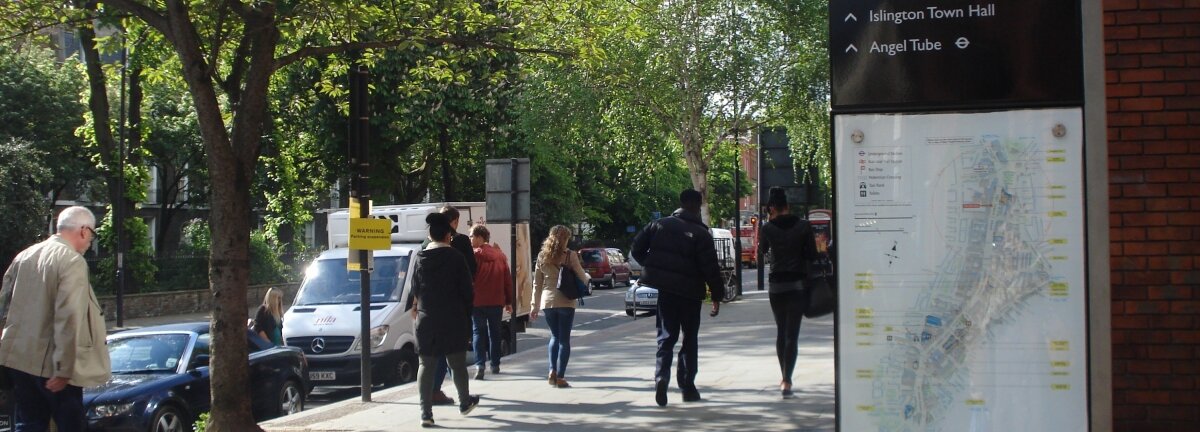Three designs that help me walk to work

Can design inspire us to walk more as part of our daily commute?
I’ve been working hard organising our upcoming Active by Design conference, so when I found out that it is Walk to Work Week, I started to wonder how design might play a part in my own journey to the office. Here are three ways that design makes walking to work an easier and more pleasant experience.
A really great app
I’ve always enjoyed walking in London. It’s often quicker than taking public transport, it saves you money, and you can see some amazing sights that you’d miss if you took the bus or the tube. Sometimes the best route isn’t obvious, and that’s when I like to use the free app Citymapper. If you want to rethink your daily commute this week, the app’s “Get Me To Work” function is particularly helpful. I also like the fact that the walking option is always given first, before other methods of transport – a great way that design can help us to be more active in our everyday lives.
As I don’t live very near to our office in Angel it would be difficult to walk the whole way to work, but I do choose to walk the last leg of the journey from Highbury & Islington train station. It’s a very straightforward route, but thanks to the app I now know that I walk 1.1 miles, and burn 92 calories (0.1 cheeseburgers apparently). The app helps me compare walking against other options – it takes a tiny bit longer than taking the bus, but saves me £1.45, which I think is a good trade-off. You don’t need to take my word for it that Citymapper is a good bit of design – it’s one of the Design Museum’s Designs of the Year.
Signs and wayfinding
It’s not just new technology that helps us to navigate our streets – traditional signs and wayfinding information are really important too.
Because I walk from Highbury & Islington to Angel every day and I know where I’m going, I don’t usually pay much attention to how well the route is marked. So I was pleasantly surprised to count 11 different signs between the two stations.
There are simple directional signs which point the way towards Angel Station; these are good to reassure you that you’re going the right way.
There are also maps on large boards. These are part of the Islington Wayfinding Project which aims to improve the pedestrian environment in the borough. These provide more detailed information, including street names, local amenities and landmarks. I like the illustrated 3D style of these maps and the fact they concentrate on Upper Street (the main high street that people are likely to walk along here). The one thing I found confusing when looking at the maps on the boards is that they are all oriented to the north, even when I was facing south.
For this reason, Transport for London’s Legible London system which shows you a map of the direction you are facing is a better example of user-centred design.
Both the Legible London maps, and the ones I saw in Islington show what is within five minutes’ walking distance, as well as a broader picture of the area. That sort of context is very useful in wayfinding, and it encourages you to make your journey by foot rather than getting a bus or taxi.
The urban environment
The design of the environment that these signs sit within is also a significant factor in making a place friendly for pedestrians. It’s no use being able to find your way if the space feels hostile.
Islington is the opposite of a toxic high street. Every morning I enjoy a bit of window shopping in the smart boutiques on my way to work, and every evening I curse that there are so many lovely little restaurants as I hungrily hurry home to cook my dinner. The character of this area is intentionally cultivated by the Council’s planners, and this makes my walk to work very pleasant.
Upper Street also gets character from the street itself. There are two things that make this public space so nice: wide pavements and leafy trees. These have a big impact on what it’s like to spend time in the area. I think I would be much less likely to walk to work if the pavement was narrow and crowded, or if the street was lined with betting shops.
Destination
When I arrive at work I always feel full of energy, and I wasn’t surprised to read that walking has been proven to increase creativity. So, why don’t you try walking to work this week? I’d be interested to hear about examples of design you encounter on your route, especially if it encourages you to be more active.
Subscribe to our newsletter
Want to keep up with the latest from the Design Council?
